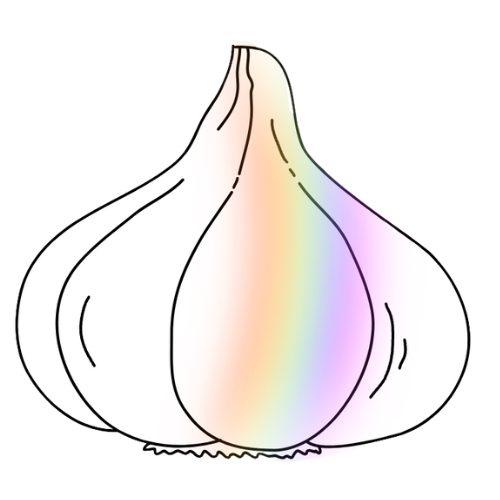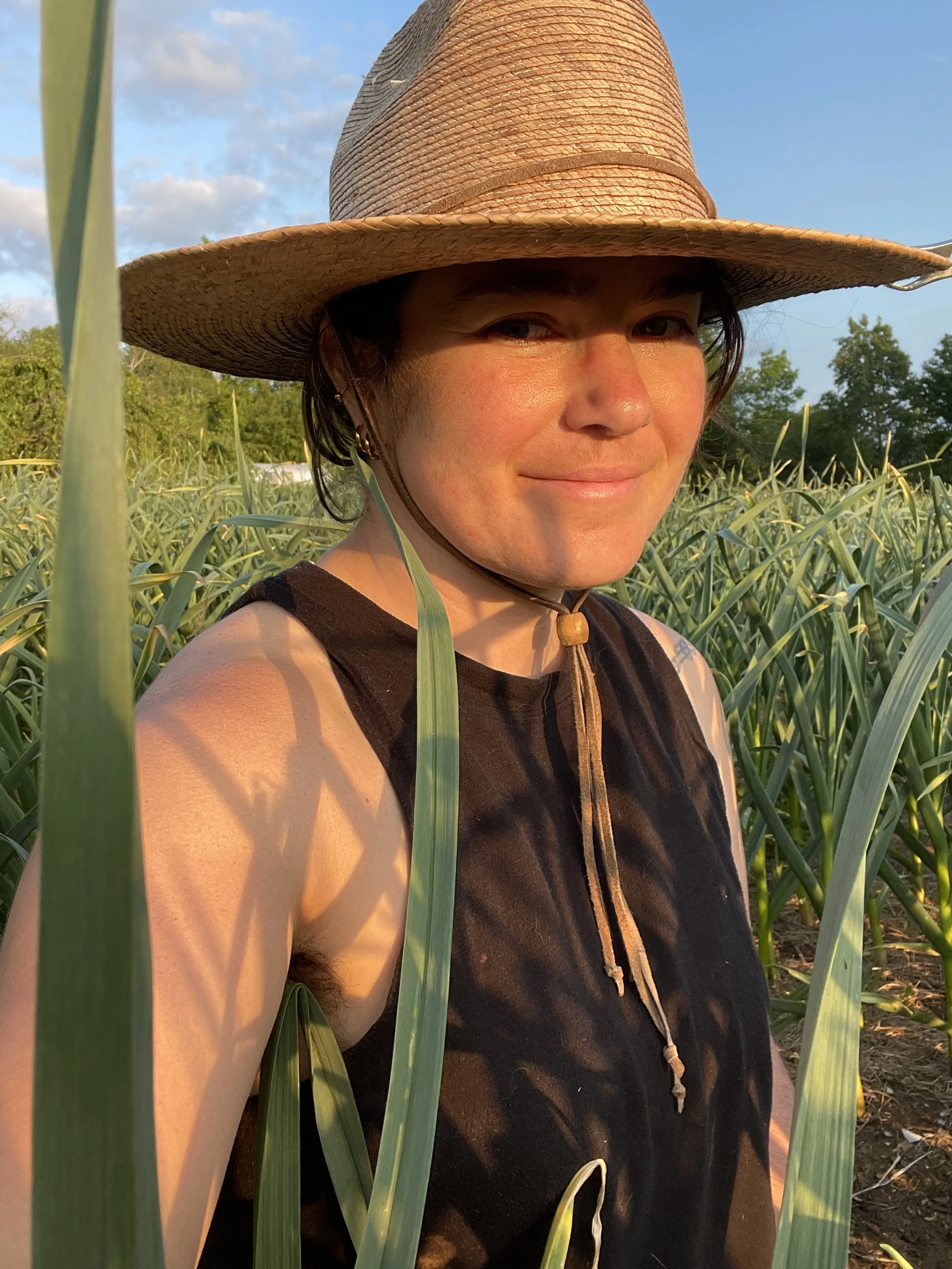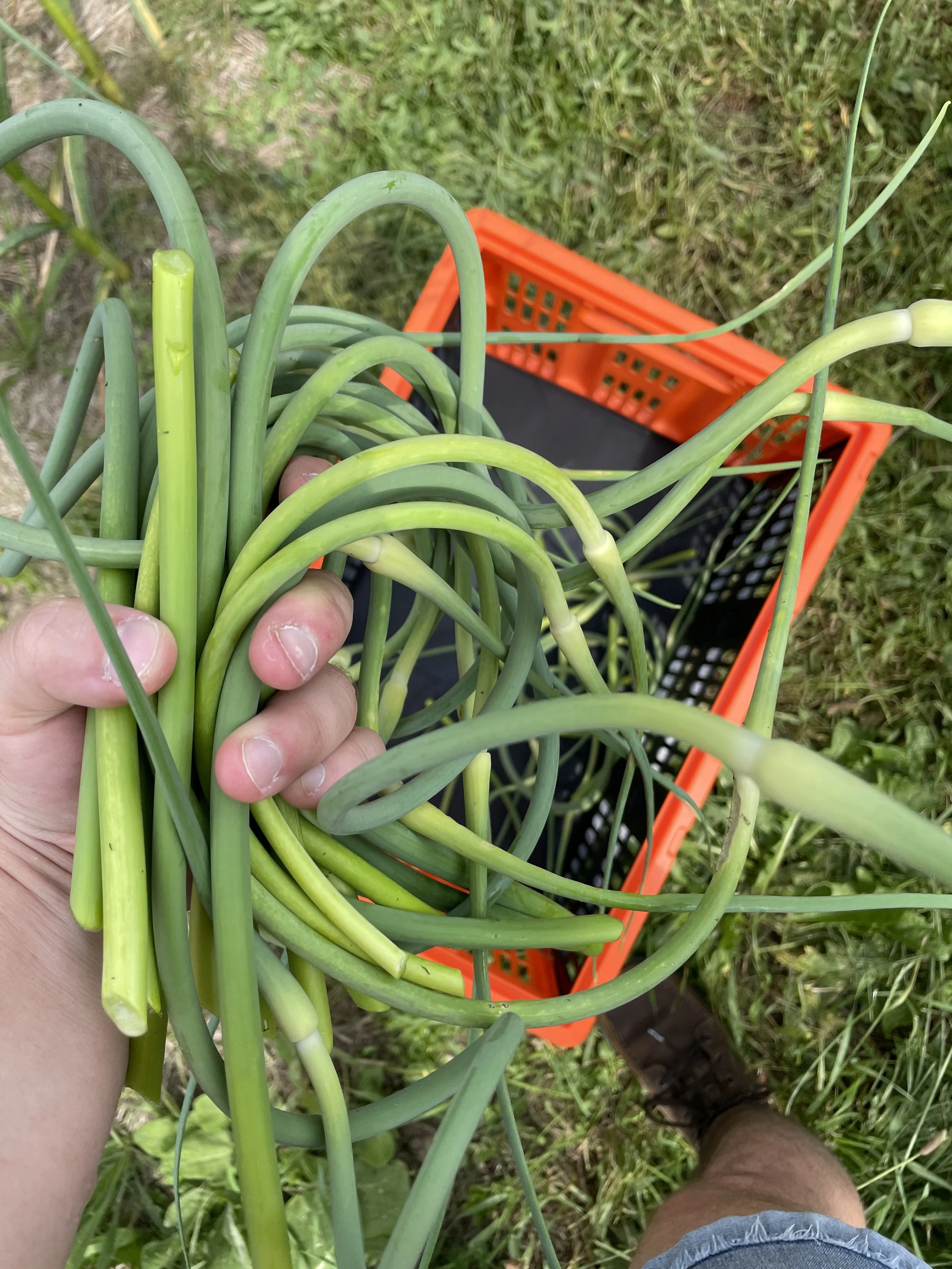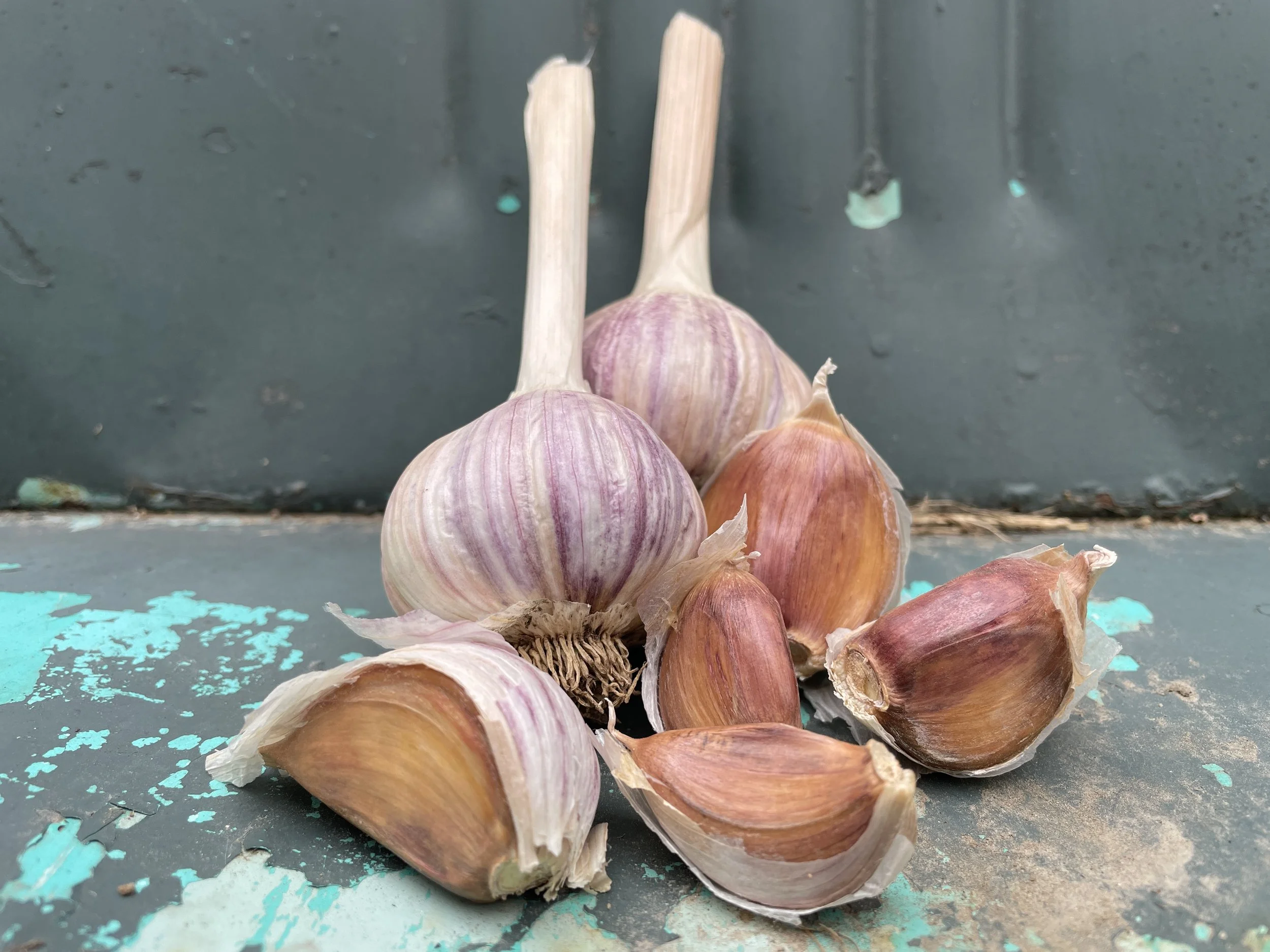Your garlic questions,
answered by garlic farmers.
Does garlic have health benefits?
Garlic contains a powerful enzyme called allicin (pronounced “Allison”). When garlic’s flesh is sliced, diced, pressed or otherwise desecrated, a chemical reaction is catalyzed that releases this sulfuric enzyme. You can thank allicin for garlic’s spicy sting and that notoriously kickin’ garlic breath!
Because of it's high allicin content, garlic has been scientifically linked to a variety of cardiovascular benefits for humans, including lowered blood pressure, a reduction of serum cholesterol, and atherosclerosis prevention. Garlic’s enzymes have also demonstrated significant anticarginogenic mechanisms that scavenge free radicals, regulate cell proliferation and inhibit the growth of tumors. It’s these same powerful antimicrobial enzymes that have made garlic a go-to support plant for combating infectious diseases for centuries. It has been demonstrated that garlic can differentiate between good gut flora and bad bacteria such as Salmonella, Escherichia coli (e coli) & h pylori! There is even evidence to indicate that garlic has a hypoglycemic affect, helping to regulate blood sugar.
Andy has a personal anecdote to share about garlic’s powerful health impact:
”When I lived in NYC, I contracted a strain of strep in my tonsils that became resistant to all antibiotics. I would get very severe strep throat flair-ups multiple times a year, often landing me in the hospital! Doctors eventually decided I needed to have a tonsillectomy, to which I was very opposed. One Summer I was attending a natural movement & biomechanics training when I started getting those familiar strep feelings. I told the instructor and she marched me out of her studio, up to her house, and grabbed a bulb of garlic from the kitchen counter. She sliced very thin slices from a clove and told me to hold it under my tongue as long as possible, moving it around occasionally so as not to burn my gums. It was intense, but I did it and it worked. Within hours I felt better and so I did it again that night. The next morning, I woke up totally free of that nasty sore, swollen throat. I’m sure moving out of NYC helped immensely, but ever since I learned about garlic’s natural antibiotic qualities, I’ve started sucking on garlic every time I feel sick and I never got strep throat again.”
IMPORTANT NOTE: All of these findings are from our own research, personal experience, & reading materials, such as The Complete Book of Garlic by Ted Meredith (highly recommended reading), and are not meant to be medical or even nutritional advice. Always consult a medical professional for medical or nutritional advice!
Can garlic lower blood pressure? Can garlic cure an h pylori infection? Are garlic pills good for you?
PRO TIP: Mince garlic & let it sit for 10 mins before sautéing or pickling for maximum allicin release, flavor, & health benefits!
How does garlic grow?
What are garlic seeds? Can you plant grocery store garlic? When do you harvest garlic?
Garlic doesn’t need to make a flower or get pollinated to reproduce - it clones itself via its own cloves! When a head, or bulb, of garlic is split apart into cloves, you can plant those as garlic seeds! Each individual clove has the potential to grow into a whole bulb of garlic. Hardneck varieties of garlic will send up a long stem called a scape that produces a florescence encasing bulbils (pictured) which are also tiny garlic clones. Planting bulbils will produce a full head of garlic after 2-3 years.
In colder climates, Hardneck varieties are the garlic of choice. Softneck varieties typically grow better in warmer climates. The garlic you buy at the grocery store is typically a softneck variety that is mass-produced in China or California. While the cloves from organic grocery store bulbs will probably grow if you plant them, it is recommended that you source garlic from a local grower if you’re going to plant it. Not only will you support your local economy, but you’ll ensure that the garlic you grow is already adapted to your microclimate. This is essential for growing garlic successfully!
In most climates, Garlic is planted in the Fall. In Vermont, we plant in October and cover the cloves with a hefty pile of straw mulch to protect them from the cold. Planted before Winter, garlic cloves will have a chance to establish roots in the soil before the freeze sets in. To successfully grow, garlic must undergo a process called vernalization, where the cloves go dormant under cold Winter temperatures. Then, in the Spring, the warming soil signals green shoots, or leaves, to pop up out of the buried clove, allowing the plant to photosynthesize and grow larger. Each leaf forms a sheath around the cloves as they begin to form and differentiate, offering protection underground. In June, hardneck garlic grows a scape - a tough stem that gives this variety its name. Once the tender scape curls at the top, it can be cut for eating. We like to make pesto, pickled scapes, or our Garlic Scape Salt! If a scape is left on the plant, it will develop a florescence, eventually producing bulbils (pictured above) which are tiny garlic clones. You can eat those, too, for a powerful garlic punch, or replant them.
Garlic is harvested in July. Dig it up with a farm fork and get it out of the sunlight as soon as possible. Garlic flesh is vulnerable at this time and can burn in the sun’s light. Garlic can be eaten fresh after harvest for a tender, powerful flavor. Allowing garlic to cure will ensure that the sheaths around each clove will dry fully & preserve the garlic for longer storage. Hardneck garlic can store for 3-6 months. Softneck varieties can last up to a year, but usually require a warmer climate to grow.
PRO TIP: Hardneck garlic varieties are closer to the original wild garlic plant, giving them a more complex flavor - chef’s choice!
Can garlic go bad?
How do you cure garlic? How do you store garlic? How long will garlic last?
Hardneck garlic, like many precious works of art, is ephemeral. It lasts, on average, about 3 months. If stored properly, certain varieties can last up to 6 months! If you’re looking for longer storage capacity, softneck varieties are the way to go, lasting up to a year. There are a few very important steps to take if you are growing your own garlic that will set you up for a long storage life.
If you want your garlic to store well, it’s important to harvest it when the soil is dry. Harvesting during or shortly after rains means you’re pulling wet bulbs out of the ground. They’ll be covered in wet earth, difficult to clean, and therefore liable to hold onto moisture or fungus and mold during curing. If you are worried about wet conditions around harvest time, it’s best to cut the garlic stems to about 4” above the bulb to remove the wet green leaves.
When curing garlic, it’s essential to eliminate the possibility of moisture forming under the drying skins. Keep fans going in your curing space, be sure there’s plenty of ventilation, and make sure it’s not too hot or cold - 72° is an ideal curing temperature. When we first started growing garlic, we made stackable wire racks (click for free building plans) and cured garlic in the garage attached to our house. We would open the garage doors during the day and keep fans going day and night. It stunk up the place when the garlic was fresh, but if you grow garlic you might like that sort of thing.
Garlic is fully cured after three weeks. Store your cured (or purchased) garlic in a cool, dry, dark place with proper ventilation (like a kitchen cupboard or a root cellar). If garlic is stored in a place that’s too warm, it will sprout. Check your garlic every so often for any unwanted moldy developments. At the end of its storage life, you’ll know because it will either show signs of rot or start to sprout green sprouts from each clove. If this happens, you should use it ASAP! If you buy a garlic variety box from Good Hill Farm, you’re going to receive mostly Hardneck varieties. Since hardneck garlic only keeps for about 3 months, we hope you enjoy it while it’s fresh!











